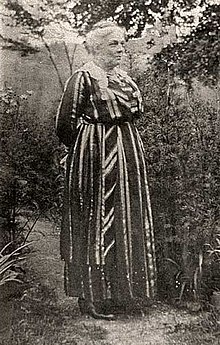
Quick Facts
Biography
Anderson Ruffin Abbott, M.D. (7 April 1837 – 29 December 1913) was the first Black Canadian to be a licensed physician. His career included participation in the American Civil War.
Early life
Anderson Abbott was born in Toronto to Wilson Ruffin and Ellen Toyer Abbott. The Abbotts were a prominent black family in Toronto, who had left Alabama – as free people of color – after their store had been ransacked. After first living a short time in New York, they settled in Upper Canada in 1835 or 1836. Wilson Abbott soon began to purchase real estate, in and around Toronto, where he owned 48 properties by 1871. The senior Abbott also became active in politics.
The family's prosperity allowed Anderson Abbott to receive an excellent education. He attended both private and public schools, including William King’s school, in the black Elgin settlement (now North Buxton, Ontario). He was an honour student at the Toronto Academy and later attended Oberlin College in Ohio. He returned to Canada and graduated from the Toronto School of Medicine in 1857. He then studied for four years under Alexander Thomas Augusta, a fellow black physician. Abbott received a license to practice, from the Medical Board of Upper Canada, in 1861, thus becoming the first Canadian-born, black doctor.
American Civil War
Anderson Abbott applied for a commission as an assistant surgeon, in the Union Army, in February 1863. His offer was not accepted, so in April he applied to be a “medical cadet” in the United States Colored Troops, before finally entering service as a civilian surgeon under contract. He served in Washington, D.C., from June 1863 to August 1865, starting at the recently opened Freedmen's Hospital (or Contraband Hospital) before moving to a hospital in Arlington, Virginia. One of only thirteen black surgeons to serve in the American Civil War, Abbott received numerous commendations and becoming popular in Washington society. This fostered a friendly relationship between Abbott and President Lincoln. On the night of Lincoln's assassination, Abbott accompanied Elizabeth Keckley to attend the stricken president at Petersen House. After Lincoln's death, Mary Todd Lincoln presented Abbott with the plaid shawl that Lincoln had worn to his 1861 inauguration.
Post-war career
In 1866, Abbott resigned from service to the Union Army and returned to Canada. He attended primary medical classes at the University of Toronto the following year. While he did not graduate, he established a medical practice and was admitted to the College of Physicians and Surgeons of Ontario in 1871. In an Anglican wedding ceremony in Toronto on 9 August 1871, he married Mary Ann Casey, the 18-year-old daughter of a successful black barber. Abbott and his wife moved to Chatham where he resumed his medical practice. They eventually had three daughters and two sons.

Like his father, Abbott soon became an important member of the black community in Toronto. From 1873 to 1880, he fought against racially segregated schools as president of the Wilberforce Educational Institute and was appointed coroner for Kent County, Ontario in 1874, the first Black man to hold that office. Abbott contributed to a local newspaper, the Chatham Planet, and was associate editor of the Missionary Messenger]], the journal of the local British Methodist Episcopal Church. Abbott was made president of both the Chatham Literary and Debating Society and the Chatham Medical Society in 1878. Abbott moved his medical practice to Dundas, Ontario in 1881. In 1883 he became a trustee of that community's high school and was chairman of the town’s internal management committee from 1885 to 1889. He also worked as an administrator for the Dundas Mechanics' Institute.
The family moved to Oakville, Ontario in 1889 but returned to Toronto the following year. He was elected a member of the local post of the Grand Army of the Republic and one of 273 Civil War veterans in Toronto to wear the badge of that fraternity. He was then known as "Captain Abbott", a rank which might reflect his office within the Grand Army of the Republic rather than his actual rank during the American Civil War. In November 1892, Abbott was appointed aide-de-camp “on the Staff of the Commanding Officers Dept.” of New York. A source of great pride for Abbott and his family, this was the highest military honour ever bestowed on a black person in Canada or the United States.
In 1894, Abbott was appointed surgeon-in-chief at Provident Hospital in Chicago, the first training hospital for black nurses in the United States. He became the hospital's medical superintendent In 1896 but resigned the following year. Returning to Toronto, Abbott resumed his private practice and became more involved with writing for various publications including the Colored American Magazine of Boston and New York, the Anglo-American Magazine of London (for which he wrote “Some recollections of Lincoln’s assassination"), and New York Age. Medicine, Black history, the Civil War, Darwinism, biology, and poetry were among his topics.
Later life
At the turn of the century he became embroiled in the debate between W. E. B. Du Bois and Booker T. Washington over social change. Siding with Du Bois, Abbott believed that Black access to higher education was essential and should not be compromised. Believing that blacks would be culturally assimilated, Abbott wrote: "It is just as natural for two races living together on the same soil to blend as it is for the waters of two river tributaries to mingle." With Canada’s black population on the decline, he thought this was especially true in his own country and wrote "by the process of absorption and expatriation the color line will eventually fade out in Canada."
Death
Anderson Ruffin Abbott died in 1913, at the age of 76, in the Toronto home of his son-in-law, Frederick Langdon Hubbard, (Toronto Transportation Commission Chairman from 1929 to 1930, and son of his long-time friend William Peyton Hubbard). He is buried in the Toronto Necropolis.
